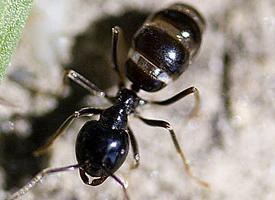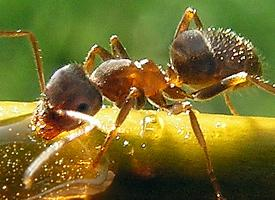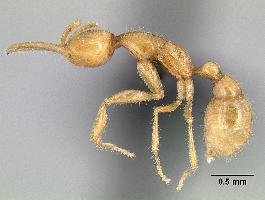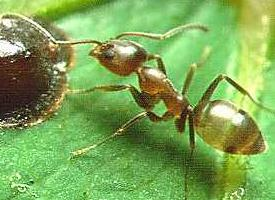
Stav ohrožení
| Ohrožen |
Popis zvířete
The Jet Ant, scientifically known as Lasius fuliginosus, is a fascinating species of ant that is part of the Formicidae family. This species is notable for its striking appearance and unique behaviors, making it an intriguing subject of study in the world of entomology.Physical Characteristics:
The Jet Ant boasts a glossy, dark brown to black exoskeleton that gives it a distinctive, almost polished look, which is how it gets its common name. Workers of this species typically measure between 4 to 5 mm in length, while queens are slightly larger, measuring up to 8 mm. Despite their small size, Jet Ants are robust and agile, equipped with strong mandibles that they use for various purposes, from foraging to nest construction.
Habitat and Distribution:
Lasius fuliginosus is primarily found in the temperate regions of Europe and parts of North Asia. They prefer wooded areas where they can easily find their primary food source and materials for nest building. Unlike many other ant species that excavate soil to create their nests, Jet Ants are known for their unique nesting behavior. They often inhabit and modify pre-existing cavities in trees or utilize abandoned nests of other ants, particularly those of the genus Formica. Inside these spaces, they construct their nests using a remarkable material known as "carton," which is made from chewed-up wood fibers mixed with their saliva.
Behavior and Diet:
Jet Ants exhibit a highly organized social structure, typical of many ant species, with a clear division of labor among workers, males, and the queen. The queen's primary role is reproduction, while the workers are responsible for foraging, nest construction, and care of the young. One of the most interesting aspects of their behavior is their relationship with aphids. Lasius fuliginosus, like many other ant species, farms aphids for their honeydew—a sweet, nutritious secretion. In return, the ants offer protection to the aphids from predators and parasites, a symbiotic relationship benefiting both parties.
Reproduction:
The reproductive cycle of the Jet Ant involves the nuptial flight, where virgin queens and males leave their nest to mate. After mating, males typically die, while fertilized queens seek suitable locations to establish new colonies. Once a new colony is founded, the queen lays her eggs, which will develop into the first generation of workers. These workers will then take over the duties of foraging and expanding the nest, allowing the queen to focus solely on laying more eggs to grow the colony.
Conservation Status:
Currently, Lasius fuliginosus is not considered to be at risk. However, like many species, they face threats from habitat destruction and environmental changes. Their reliance on specific types of habitats makes them vulnerable to the effects of deforestation and urbanization.
In conclusion, the Jet Ant (Lasius fuliginus) is a remarkable species with unique characteristics and behaviors. From their glossy appearance to their complex social structure and symbiotic relationships with aphids, these ants are a testament to the diversity and intricacy of the natural world. Their presence in ecosystems underscores the importance of preserving natural habitats to ensure the survival of such fascinating species.
Podobná zvířata
Nové fotografie zvířat
Top 10 zvířat
- Chinese water dragon (Physignathus cocincinus)
- Galápagos tortoise (Geochelone nigra complex)
- Dolphin gull (Leucophaeus scoresbii)
- Japanese macaque (Macaca fuscata)
- Colombian red howler (Alouatta seniculus)
- Sea urchins (Echinoidea)
- Diana monkey (Cercopithecus diana)
- Moustached guenon (Cercopithecus cephus)
- Colossal squid (Mesonychoteuthis hamiltoni)
- Common house mosquito (Culex pipiens)


